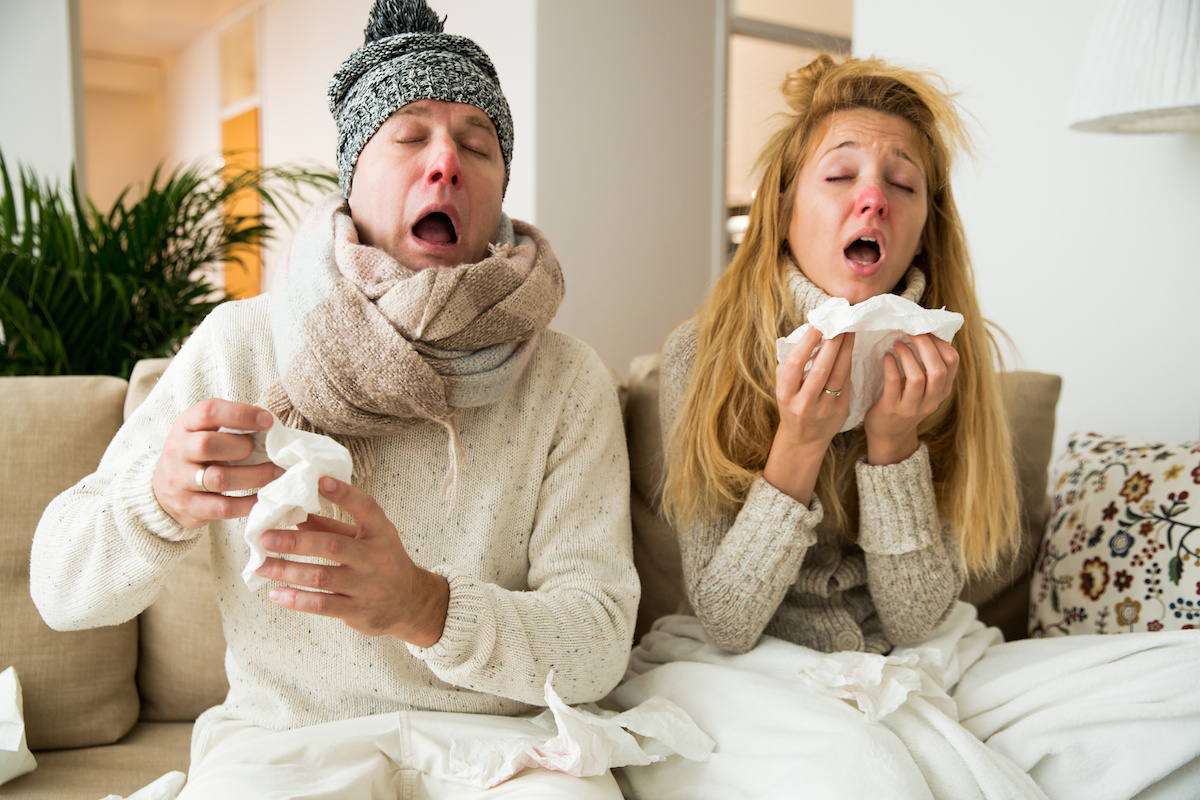The “Flu” or Influenza
October 27, 2006 – Update: This year it’s estimated that between 40 and 90 million Americans will come down with the flu between the months of November and March. Most of those people will suffer with the aches and pains for a few days and then recover. An average of 114,000 people are hospitalized for flu-related complications yearly, and 36,000 Americans die each year from complications of flu. (Source: CDC)
 Influenza, commonly called “the flu”, is an infection of the respiratory tract caused by the influenza virus. There are three types of viruses — influenza A, B and C. Types A and B are to blame for majority of respiratory illness that occur most winters. Type C causes mild illness or no symptoms at all. Flu viruses are spread from one person to another by sneezing, coughing or direct contact, that is why we call them airborne.
Influenza, commonly called “the flu”, is an infection of the respiratory tract caused by the influenza virus. There are three types of viruses — influenza A, B and C. Types A and B are to blame for majority of respiratory illness that occur most winters. Type C causes mild illness or no symptoms at all. Flu viruses are spread from one person to another by sneezing, coughing or direct contact, that is why we call them airborne.
Compared with most other viral respiratory infections, such as the common cold, influenza infection often causes a more severe illness. Typical influenza illness includes fever (usually 100°F to 103°F in adults and often even higher in children) and respiratory symptoms, such as cough, sore throat, runny or stuffy nose, as well as headache, muscle aches, and often extreme fatigue, you may feel shivery and rotten and all you want to do is to lie down. These problems usually last 3-4 days. There is no treatment as antibiotics don’t work against viruses.
Every year an estimated 25 million to 50 million Americans contract the flu.
The flu can be life-threatening for infants, young children, the elderly, those with chronic illnesses or those whose immune system is compromised like people with AIDS, people undergoing cancer treatment, people with lupus and other immune deficiencies. About 20,000 die from influenza complications each year. Bacterial pneumonia is the most common serious complication.
If you get the flu?…. rest, rest, rest. You will feel lousy for several days.

What to do for the flu? Lie down and rest. Take Tylenol (generic is fine) as directed on the label for fever, and muscle aches. Drink lots of clear fluids and water, stay away from anyone you like or you will spread it to them and listen to your body. If you need to sleep, do that. There is no treatment for the flu since antibiotics do not work against viruses. They are used if you get bronchitis or pneumonia as a complication of the flu.
Most people who get the flu recover completely in ten days to two weeks.
To avoid the flu? Eat right, sleep well at night, and wash, wash, wash your hands! Hand washing is especially important after you have been in a public place like the mall or school. You most likely will pick up the virus from a surface of something, even a doorknob. See the ‘common cold‘ for more on how viruses are spread, it’s really the same thing, only this virus packs more of a punch.
Very important: Avoid touching your eyes, nose or mouth until after you have washed your hands! Germs are often spread when a person touches something that is contaminated with germs and then touches his or her eyes, rubs their eyes, nose, or mouth.
How The Flu Spreads
The flu spreads in respiratory droplets caused by coughing and sneezing. It usually spreads from person to person, though occasionally a person may become infected by touching something with virus on it and then touching their mouth or nose.
Adults may be able to infect others beginning 1 day before getting symptoms and up to 7 days after getting sick. That means that you can give someone the flu before you know you’re sick as well as while you are sick.
![]()
Some History of Human Influenza
Antigenic shift occurs only occasionally. When it does occur, large numbers of people, and sometimes the entire population, have no antibody protection against the virus. If the new virus is capable of being spread easily from person to person, a worldwide epidemic, called a pandemic, can occur. During this century, pandemics occurred in 1918, 1957, and 1968, each of which resulted in large numbers of deaths, as noted below. Mortality associated with pandemics
- 1918-19 “Spanish flu” — Caused the highest known influenza-related mortality: approximately 500,000 deaths occurred in the United States, 20 million worldwide.
- 1957-58 “Asian flu A” — 70,000 deaths in the United States.
- 1968-69 “Hong-Kong flu” — 34,000 deaths in the United States.
![]()
Influenza Vaccine
Flu Vaccine
There are two types of vaccines:
* The “flu shot” — an inactivated vaccine (containing killed virus) that is given with a needle. The flu shot is approved for use in people older than 6 months, including healthy people and people with chronic medical conditions.
* The nasal-spray flu vaccine — a vaccine made with live, weakened flu viruses that do not cause the flu (sometimes called LAIV for “Live Attenuated Influenza Vaccine”). LAIV is approved for use in healthy people 5 years to 49 years of age who are not pregnant. About two weeks after vaccination, antibodies that provide protection against influenza virus infection develop in the body.
When to Get Vaccinated
October or November is the best time to get vaccinated, but you can still get vaccinated in December and later. Flu season can begin as early as October and last as late as May.
Who Should Get Vaccinated?
Because of a shortfall in flu shot production for this season, CDC is recommending that certain people be given priority for getting the flu shot. People in the following groups should seek vaccination this season:
- all children aged 6–23 months;
- adults aged 65 years and older;
- persons aged 2–64 years with underlying chronic medical conditions;
- all women who will be pregnant during the influenza season;
- residents of nursing homes and long-term care facilities;
- children aged 6 months–18 years on chronic aspirin therapy;
- health-care workers involved in direct patient care; and
- out-of-home caregivers and household contacts of children aged <6 months.These are people who are at high risk for serious flu complications or are in contact with people at high risk for serious flu complications.
People who are not included in one of the priority groups listed above are asked to forego or defer vaccination because of the vaccine supply situation.
Who Should Not Be Vaccinated
There are some people who should not be vaccinated. These include:
- People who have a severe allergy to chicken eggs.
- People who have had a severe reaction to an influenza vaccination in the past.
- People who developed Guillain-Barré syndrome (GBS) within 6 weeks of getting an influenza vaccine previously.
- Children less than 6 months of age.People who are sick with a fever. (These people can get vaccinated once their symptoms lessen.) Other Good Health Habits
- Avoid close contact.
Avoid close contact with people who are sick. When you are sick, keep your distance from others to protect them from getting sick too. - Stay home when you are sick.
If possible, stay home from work, school, and errands when you are sick. You will help prevent others from catching your illness. - Cover your mouth and nose.
Cover your mouth and nose with a tissue when coughing or sneezing. It may prevent those around you from getting sick. - Clean your hands.
Washing your hands often will help protect you from germs. - Avoid touching your eyes, nose or mouth.
Germs are often spread when a person touches something that is contaminated with germs and then touches his or her eyes, nose, or mouth.
 Much of the illness and death caused by influenza can be prevented by annual influenza vaccination. Influenza vaccine is specifically recommended for people who are at high risk for developing serious complications as a result of influenza infection. These high-risk groups include all people aged 65 years or older and people of any age with chronic diseases of the heart, lung or kidneys, diabetes, immunosuppression, or severe forms of anemia.
Much of the illness and death caused by influenza can be prevented by annual influenza vaccination. Influenza vaccine is specifically recommended for people who are at high risk for developing serious complications as a result of influenza infection. These high-risk groups include all people aged 65 years or older and people of any age with chronic diseases of the heart, lung or kidneys, diabetes, immunosuppression, or severe forms of anemia.
Beginning in 2000, all person aged 50-64 years were added to the groups recommended for annual vaccination. Influenza vaccine is also recommended for people who are in close or frequent contact with anyone in the high-risk groups. These people include health care personnel and volunteers who work with high risk patients and people who live in a household with a high-risk person.
Some people are not vaccinated because of misconceptions about influenza and the vaccine. Many people are not aware of the seriousness of influenza infection and some believe that the vaccine can cause the flu. Influenza vaccine produced in the United States cannot cause influenza. The only type of influenza vaccine that has been licensed in the United States is made from killed influenza viruses, which cannot cause infection. An influenza vaccine that is made with live influenza viruses has been developed and may be marketed in the future. This vaccine is made with viruses that can provide antibody protection but do not cause classic influenza symptoms.
The nasal-spray flu vaccine (sometimes called LAIV for Live Attenuated Influenza Vaccine) is a new flu vaccine that was licensed in 2003. It is different from the other influenza vaccine (also called the ‘flu shot’) because it contains weakened live influenza viruses instead of killed viruses and is administered by nasal spray instead of injection.
How does the nasal-spray flu vaccine (LAIV) work? The nasal-spray flu vaccine contains three different live (but weakened) influenza viruses. When the viruses are sprayed into the nose, they stimulate the body’s immune system to develop protective antibodies that will prevent infection by naturally occurring influenza viruses. When in doubt if you can get the flumist vaccine, call your health care provider.
![]()
Why the Vaccine Must Be Taken Every Year
![]() Although only a few different influenza viruses circulate at any given time, people can become ill with the flu many times in their lives. The reason for this continuing susceptibility is that influenza viruses are continually changing, usually as a result of mutations in the viral genes. Currently, there are three different influenza virus strains, and the vaccine contains viruses representing each strain. Each year the vaccine is updated to include the most current influenza virus strains. The fact that influenza viruses continually change is one of the reasons vaccine must be taken every year. Another reason is that antibody made after being vaccinated declines over time, and antibody levels are often low one year after vaccination.
Although only a few different influenza viruses circulate at any given time, people can become ill with the flu many times in their lives. The reason for this continuing susceptibility is that influenza viruses are continually changing, usually as a result of mutations in the viral genes. Currently, there are three different influenza virus strains, and the vaccine contains viruses representing each strain. Each year the vaccine is updated to include the most current influenza virus strains. The fact that influenza viruses continually change is one of the reasons vaccine must be taken every year. Another reason is that antibody made after being vaccinated declines over time, and antibody levels are often low one year after vaccination.
When To Receive Influenza Vaccine
![]() In the United States, influenza usually occurs from about November until April, with activity peaking between late December and early March. The optimal time for vaccination of persons at high risk for influenza — related medical complications is during October through November. However, to avoid missed opportunities for vaccination, vaccine should be offered to high — risk persons who are hospitalized or seen at their physician’s office starting in September and continuing through the winter. It takes about one to two weeks after vaccination for antibody against influenza to develop and provide protection.
In the United States, influenza usually occurs from about November until April, with activity peaking between late December and early March. The optimal time for vaccination of persons at high risk for influenza — related medical complications is during October through November. However, to avoid missed opportunities for vaccination, vaccine should be offered to high — risk persons who are hospitalized or seen at their physician’s office starting in September and continuing through the winter. It takes about one to two weeks after vaccination for antibody against influenza to develop and provide protection.
Some of this information provided by the U.S. Centers for Disease Control and Prevention
Check out these other pages for more…
- The Common Cold…
- Understanding the ‘Flu Virus’...
- New Beating the Flu
- The Influenza Vaccine
- Are Allergies Your Problem?
Get More Info on OralFlu Protect for natural prevention and treatment of the flu.
